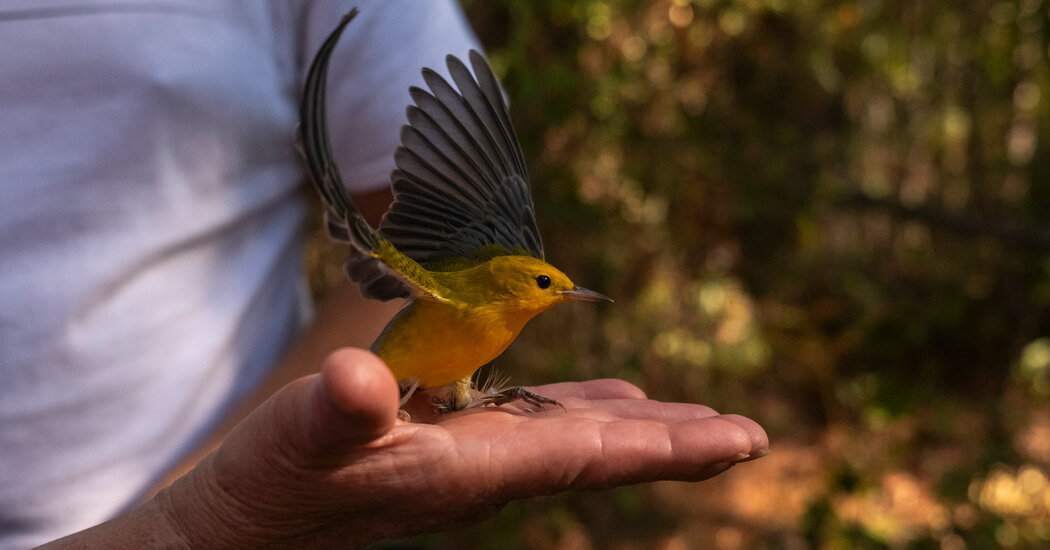On a map of the US, you’ll be able to barely see the skinny strip of land that’s Fort Morgan, Alabama. However the slim peninsula — about 20 miles lengthy and, in some locations, lower than half a mile — is of nice significance to migratory birds: it’s the final land cease earlier than they fly south throughout the Gulf of Mexico.
at latest days, Domain Alliance of the Americas He spent 9 days within the dense vegetation of Fort Morgan, the place he rigorously caught the birds in mist nets, tied their legs with small bands after which launched them again into the world for his or her lengthy journey throughout the water.
By the top of the occasion, BCA co-founders Emma Rhodes and Kyle Shepherd, together with a crew of 10 or so skilled and federally licensed volunteers, had captured and banded 527 birds of 55 totally different species.
Seeing birds up shut and holding them in your hand could make a distinction, mentioned Ms. Rhodes, 28, a chicken biologist with a Ph.D. Pupil at Auburn College. “This will actually change individuals’s lives and provides them new views on why birds are vital, why this habitat is vital, and why this habitat should not simply be residences,” she mentioned.
Ms. Rhodes and Mr. Shepherd have been skilled to band birds in Fort Morgan as kids, when their academics, Bob and Martha Sargent, led a nonprofit group devoted to the examine and conservation of hummingbirds and different migratory neotropical birds. The Sargents have now handed away, and in 2020, Ms Rhodes and Mr Shepherd based BCA as a approach to proceed the work.
Mr. Shepherd, 30, began band follow in Fort Morgan when he was 12 years outdated. When persons are thinking about volunteering, he mentioned, “My first query is, effectively, how a lot time do it’s a must to commit to it? As a result of it is going to final for the remainder of your life, the coaching won’t ever finish.
Ms Rhodes added that giving individuals the chance to volunteer was vital to each of them. “We had the privilege and privilege of coaching at a really younger age and we actually felt that it modified our path and path in life for the higher,” Ms Rhodes mentioned.
Knowledge collected by BCA is reported to Bird banding laboratorya program administered by the USGS, in collaboration with the Canadian Hen Banding Bureau, manages the North American Hen Banding Program.
After all, birds know no boundaries. Species captured and launched by BCA are only a cease in Alabama. “Loads of instances we are saying, ‘Oh, the North American species,’ however they’re truly not the North American species,” Ms. Rhodes mentioned. “They’re unfold all through the Americas and we’re sharing them.”
The crew usually finds some surprises behind the online. “This 12 months we collected Western tanagers, which weren’t purported to be there,” Ms. Rhodes mentioned with fun. The chicken’s typical habitat is the far west. “We additionally collected two western wooden species” — once more, not the jap species, she added.
The information collected by the BCA will assist scientists discover bigger tendencies. “We could also be seeing a rise within the variety of western birds yearly, and that is one thing that must be documented,” Ms Rhodes mentioned.
Finally, she added, one of many group’s objectives is to share and alternate information with different areas: “Particularly with individuals within the tropics, as a result of it’s a must to perceive the entire annual cycle of chicken conservation.” “You may’t simply examine it within the winter.”
Ms Rhodes mentioned she additionally loved seeing birds up shut, even widespread species. Amongst her favorites is the American red-started male, nicknamed the Halloween chicken due to its black and orange plumage. It connects him to Fort Morgan, particularly within the fall. “We collected a whole lot of them,” she mentioned. She mentioned it was vital to the ecosystem and to the work she devoted her life to. But in addition: “They’re simply lovely birds.”

